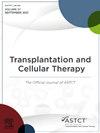G-CSF-Primed Peripheral Blood Stem Cell Haploidentical Transplantation Could Achieve Satisfactory Clinical Outcomes for Severe Aplastic Anemia Patients
IF 4.4
3区 医学
Q2 HEMATOLOGY
引用次数: 0
Abstract
Background
Allogeneic hematopoietic stem cell transplantation (allo-HSCT) continues to be a cornerstone in the treatment of severe aplastic anemia (SAA). The advancement of haploidentical hematopoietic stem cell transplantation (haplo-HSCT) has broadened therapeutic possibilities, particularly for patients lacking fully human leukocyte antigen (HLA)-matched donors. However, it still remains unclear which type of graft source is better for SAA patients underwent haplo-HSCT.
Objectives
This study aimed to assess the clinical outcomes of haplo-HSCT using granulocyte colony-stimulating factor (G-CSF)-primed peripheral blood (G-PB) as the graft source, comparing them to a control group receiving G-CSF-primed bone marrow (BM) plus G-PB (BM+PB).
Study design
This was a single-center, retrospective, case-pair cohort study. Between January 2020 and December 2023, a total of 278 consecutive SAA patients received haplo-HSCT in Peking University People’s Hospital. In total, 22 patients receiving haplo-HSCT using PB were included in this study. To minimize the impact of potential confounders in this study, we used the propensity score matching (PSM) method to match patients who underwent haplo-HSCT with G-PB plus G-BM at the same time with a 3:1 ratio using nearest-neighbor matching. In the end, 88 patients were included in this study. A total of 22 patients received PB stem cells as graft and 66 patients received G-CSF-primed BM plus PB as graft.
Results
The PB group demonstrated greater neutrophil (100% vs. 93.9%, P = .04) and platelet engraftment (95.5% vs. 89.0%, P = .03) incidence compared with the BM+PB group. There were no significant differences in the cumulative incidences of grades II–IV (13.6% vs. 25.8%, P = .28) or grades III–IV acute graft-versus-host disease (aGVHD; 4.5% vs. 4.6%, P = .99) between the PB group and BM+PB group. The PB group (36.7%) exhibited a trend toward a higher incidence of chronic GVHD compared to BM+PB group (24.1%). However, the difference between the two groups was not statistically significant. Moreover, the immune reconstitution of CD3+T cells, CD4+T cells, CD8+T cells and CD19+B cells were also comparable between two groups. At 3 years post-haplo-HSCT, the probabilities of overall survival (OS), failure-free survival (FFS), and GVHD-free/failure-free survival (GFFS) were 86.1% versus 87.9% (P = .90), 86.1% versus 83.3% (P = .73) and 76.5% versus 75.2% (P = .70) for PB and BM+PB group, respectively. In univariate analysis, the graft source did not influence the clinical outcomes after HSCT.
Conclusions
This study illustrated the safety and efficacy of haplo-HSCT with PB being the single graft source as the treatment for SAA, providing a basis for further potential optimization of the current protocol. In the future, this conclusion should be further tested by prospective randomized trials.
g - csf诱导外周血干细胞单倍体移植治疗重度再生障碍性贫血临床效果满意
背景:同种异体造血干细胞移植(Allo-HSCT)仍然是治疗严重再生障碍性贫血(SAA)的基石。单倍体造血干细胞移植(haploo - hsct)的进步拓宽了治疗的可能性,特别是对于缺乏完全匹配hla供体的患者。然而,对于接受单倍造血干细胞移植的SAA患者来说,哪种类型的移植源更好仍不清楚。目的:本研究旨在评估使用粒细胞集落刺激因子(G-CSF)引发的外周血(G-PB)作为移植源的单倍造血干细胞移植的临床结果,并将其与接受G-CSF引发的骨髓(BM) + G-PB (BM + PB)的对照组进行比较。研究设计:这是一项单中心、回顾性、病例对队列研究。2020年1月至2023年12月,共有278例SAA患者连续在北京大学人民医院接受单倍造血干细胞移植。本研究共纳入22例使用PB接受单倍造血干细胞移植的患者。为了尽量减少本研究中潜在混杂因素的影响,我们使用倾向评分匹配(PSM)方法,以3:1的比例使用最近邻匹配,将同时接受单倍hsct的患者与G-PB + G-BM进行匹配。最终,88例患者被纳入本研究。22例患者接受PB干细胞移植,66例患者接受g - csf引物BM + PB移植。结果:与BM + 组相比,PB组中性粒细胞(100% vs. 93.9%, p=0.04)和血小板植入(95.5% vs. 89.0%, p=0.03)发生率更高。II-IV级(13.6% vs. 25.8%, p = 0.28)或III-IV级急性移植物抗宿主病(aGVHD) (4.5% vs. 4.6%, p = 0.99)的累积发病率在PB组和BM+PB组之间无显著差异。与BM+PB组(24.1%)相比,PB组(36.7%)表现出慢性GVHD发生率更高的趋势;但两组间差异无统计学意义。两组间CD3+T细胞、CD4+T细胞、CD8+T细胞和CD19+B细胞的免疫重构也具有可比性。单倍hsct后三年,PB和BM + PB组的总生存率(OS)、无失败生存率(FFS)和无gvhd /无失败生存率(GFFS)的概率分别为86.1%对87.9% (p = 0.90)、86.1%对83.3% (p = 0.73)和76.5%对75.2% (p = 0.70)。在单因素分析中,移植来源不影响移植后的临床结果。结论:本研究说明了以PB为单移植源的单倍hsct治疗SAA的安全性和有效性,为进一步优化现有方案提供了基础。在未来,这一结论需要通过前瞻性随机试验进一步验证。
本文章由计算机程序翻译,如有差异,请以英文原文为准。
求助全文
约1分钟内获得全文
求助全文
来源期刊

Transplantation and Cellular Therapy
Medicine-Hematology
CiteScore
7.00
自引率
15.60%
发文量
1061
审稿时长
51 days
 求助内容:
求助内容: 应助结果提醒方式:
应助结果提醒方式:


